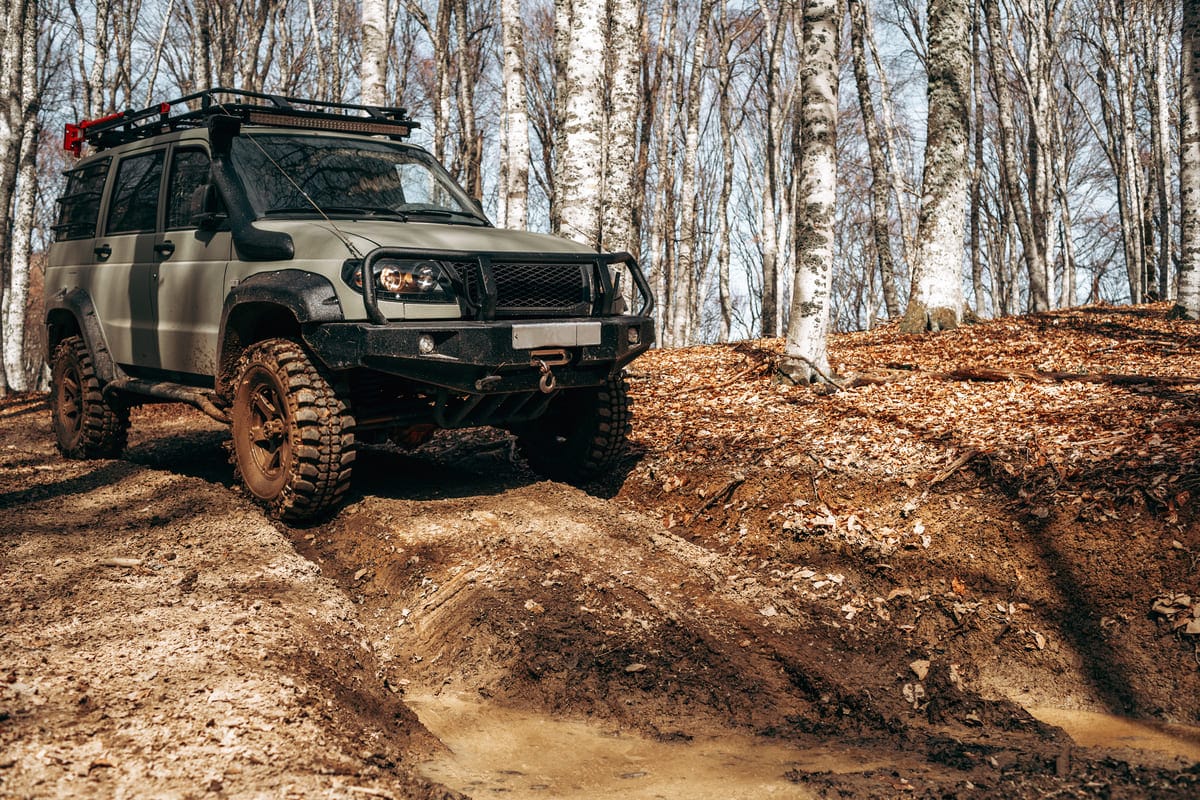Frequently utilized in off-road and utility vehicles, four-wheel drive ensures enhanced stability and performance under adverse conditions, making it indispensable for adventurous driving.
What Is Four-Wheel Drive?
Four-Wheel Drive also known as 4WD, 4×4 and 4- drive is a system that allows a vehicle to power all 4 of its wheels at the same time. This gives the vehicle better traction on rough terrain like mud, snow or rocky roads.
In many vehicles you can turn 4WD on and off. When you turn it on the engine sends power to both front and rear wheels. This makes the vehicle more stable and easier to handle.
People use four-wheel drive in SUVs, trucks and off-road vehicles. It’s for driving on trails, climbing hills or getting through deep snow.
There are two types of four-wheel drive: part-time and full-time. Part-time systems let you choose when to use 4WD, full-time systems always engage all wheels.
Remember 4×4 can be safer but uses more fuel. Use it when you need extra grip or stability.
References
- Four-wheel drive. Retrieved from
- Four-Wheel Drive. ScienceDirect. Retrieved from
- Four-wheel drive. Cambridge Dictionary. Retrieved from
What is the History of Four Wheel Drive?
The concept of Four-Wheel Drive (4WD) started in the early 1900s. The first 4WD was the “Spyker 60 HP” made by Dutch brothers Jacobus and Hendrik-Jan Spijker in 1903.
During World War I military vehicles needed better traction and stability. Engineers developed 4WD systems to help these vehicles move on rough terrain.
In 1916 the British company F.W.D. (Four Wheel Drive Auto Company) made trucks with 4WD. These trucks carried heavy loads over rough terrain during the war.
World War II saw more development. The American Jeep built by Willys-Overland used 4WD to navigate battlefields. It became famous for its ruggedness and reliability.
After the wars civilians wanted 4WD for outdoor adventures. Companies like Jeep, Land Rover and Toyota started making 4WD vehicles for everyday use. By the 1960s 4WD was for off-road driving.
In the 1980s and beyond technology improved. Car makers added features like automatic 4WD systems and electronic controls. Today many SUVs, trucks and even some cars use advanced 4WD systems for all kinds of driving.
References
- Four-wheel drive. Retrieved from
What Are the Benefits of Four-Wheel Drive?
Four-Wheel Drive (4WD) systems have many advantages for drivers especially in tough conditions. By sending power to all 4 wheels 4WD gives you more traction, stability and . Whether you’re driving on rough terrain or towing heavy loads 4WD gives you the extra control and capability for all kinds of driving.
Better Traction
- All 4 wheels get power, more grip on the road.
- Especially useful in snow, mud, sand or wet conditions.
- Reduces the chance of skidding or slipping.
Improved Stability
- Helps the vehicle stay balanced on uneven terrain.
- Prevents the vehicle from getting stuck or tipping over.
- Makes driving on hills and rocky trails safer.
Off-Road Capabilities
- Allows you to explore rough off-road areas.
- Ideal for activities like camping, hiking and nature trips.
- Access places where regular cars can’t go.
Enhanced Towing Power
- Gives you extra power to tow trailers, boats or other vehicles.
- Improves control and safety while towing.
- Reduces strain on the vehicle when pulling heavy loads.
Emergency Situations
- Helps you navigate through snowstorms, mud or other tough conditions.
- Increases chances of getting out of difficult spots safely.
- Essential for emergency responders in tough environments.
Overall Safety
- Gives you more driver control and confidence in adverse weather.
- Reduces accidents caused by poor traction.
- Makes driving safer in all conditions.
References
- What Are the Benefits of a 4-Wheel Drive?. Retrieved from

How Does Four-Wheel Drive Work?
Four-Wheel Drive (4WD) helps vehicles get more traction and stability by powering all four wheels. Here’s how 4WD works:
Step 1: The Engine Makes Power
- The engine makes the vehicle move.
- This power needs to get to all four wheels for 4WD to work.
Step 2: The Transfer Case Splits the Power
- The transfer case is a special gearbox.
- It splits the engine’s power between the front and rear axles.
Step 3: Drive Shafts Carry the Power
- Drive shafts are long rods connected to the transfer case.
- They carry the split power to the front and rear axles.
Step 4: Differentials Distribute the Power
- Differentials are gears on each .
- They distribute power to the wheels on both sides of the vehicle.
Step 5: Wheels Get Power
- All four wheels now get power from the differentials.
- This helps the vehicle get more grip and stability.
Step 6: You Control the 4WD System
- Some vehicles have a switch or lever to turn 4WD on and off.
- Others have automatic systems that turn 4WD on when needed.
By following these steps 4WD makes sure the power gets to all four wheels and gives you more control and traction in tricky driving conditions.
References
- How Four-Wheel Drive Works. HowStuffWorks. Retrieved from
- Four-Wheel Drive (4WD) in Cars: Types, Advantages and Disadvantages. Digit Insurance. Retrieved from
What is the Difference Between Four Wheel Drive and AWD?
Four-Wheel Drive (4WD) and All-Wheel Drive (AWD) both improve traction and control but work differently and are suited for different needs.
4WD:
Intended Use:
- Best for off-road driving and tough terrain like mud, snow and rocks.
- Common in trucks and SUVs designed for rough conditions.
Power Distribution:
- Sends power to all four wheels but usually requires manual activation.
- Often has low-range gearing for extreme off-road situations.
Driver Control:
- Drivers can switch between 2WD and 4WD modes.
- Gives more control over when and how to use the system.
AWD:
Intended Use:
- For on-road driving with some light off-roading.
- Found in many cars, crossovers and some SUVs.
Power Distribution:
- Sends power to all four wheels all the time.
- Uses sensors to adjust power distribution based on driving conditions.
Driver Control:
- No input required from the driver; it works automatically.
- Enhances safety and handling in normal driving conditions.
Key Differences:
- Control: 4WD gives you more control, AWD adjusts automatically.
- Use: 4WD is for off-road and heavy use; AWD is for everyday driving.
- Power: 4WD can be turned off to save fuel; AWD stays on to maintain traction.
Understanding these differences helps you choose the right system for your driving needs.
References
- What Is the Meaning of 4×4 Cars and Trucks?. Toyota of Anaheim. Retrieved from
- AWD vs 4WD. AckoDrive. Retrieved from https://ackodrive.com/car-guide/awd-vs-4wd/


